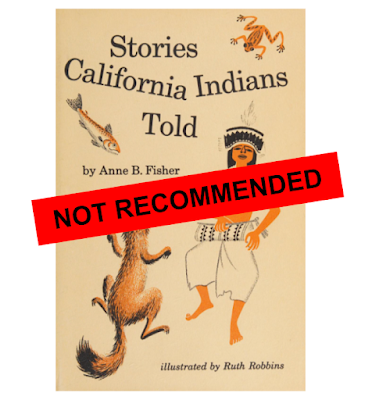Several readers have asked me about Stories California Indians Told by Anne B. Fisher, illustrated by Ruth Robbins. It came out in 1957 from Parnassus Press in Berkeley, California.
Whenever I am asked about a book, the first questions I pose are these: Who wrote it? When did it come out? What are the author's sources? What verb tense is used? I also consider the title and what it conveys.
I'd like everyone to pose those questions, too.
With this book, we see a problem right away in the title. The problem is the word "told." It implies the stories are not being told today. Switch that past tense word for its present tense form: tell. If the title was Stories California Indians Tell, it conveys a living people. I am not suggesting a simple change in a verb in the title would make this book acceptable.
As far as I am able to ascertain, the author and illustrator of the book are not Native.
Its publication date is 1957. What awareness did the author and her editor have, about Native peoples and how we feel about representation? Native people knew we were being misrepresented but did not have access to tools we have today (social media). Since then, the publishing world has become more informed and I doubt this book would get published.
In the book's Forward, I see that the source is Dr. C. Hart Merriam, who "wrote the tales down just as they were told to him by Indian story-tellers." Merriam then told the stories to Fisher (the author), who "turned them into stories for children and young people." One option a researcher can do is look for the source material and compare the source with how it was adapted (in this case, by Fisher). What was left in? What was not used? But when doing that particular kind of study, you'd need to see how reliable the source (C. Hart Merriam) was. In previous studies I've done, I've found those sources lacking. People who gathered the source material were outsiders looking in, not understanding what they were observing. They sometimes forced their own interpretations on what they observed.
The Forward is written by an anthropology professor at San Francisco State College. His name: Adan E. Treganza. In the forward, several specific tribal nations are named by geographical location. All through there, however, are past tense verbs. Treganza uses "stories" and "myths" and "tales" to describe the contents of the book. In the final paragraph, Treganza writes that the characters in the myths do things that "appear to be impossible." He continues (p. 6):
California Indians, like all other people, were imaginative and attempted to explain in their myths the world of nature around them. Animals, reptiles, or insects were often given the ability to think and speak like humans and to exert almost unlimited physical powers. Yet these stories were very real to Indian children and adults, as real as our own legendary tales are to us."
At the moment, I'm looking at verb tense again. The stories "were" real. Are they not real anymore? It pains me to write something that should be obvious to everyone, but, Native peoples in California tell stories, today. Do they tell the ones in this book? I'm doubtful. Let's look at the first one.
The first story in Stories California Indians Told is "How California Was Made." In it, "the Medicine Man of the Gabrielino Indians" sees leaves falling, which signals that "the time for story telling was here." He paints his body, puts on a headdress, went outside of his hut, and called out "Come sit around the fire and I will tell you a story." From all the huts around his, Indian men and their wives and the Indian boys and girls came running. The people loved stories and they loved Medicine Man to tell them." The story he tells is about how the Great Spirit made land using several turtles, who he told to get in a long north-south line, head to tail, with the three at the southerly end placed more towards the east. "You'll make a wonderful California!" he told them.
The story goes on but I'll pause there so we can critically analyze the information summarized above.
In the first story in this book, we're asked to believe that a Native man whose people have lived on this continent since time immemorial is telling his people their creation story -- and calling their land by a name outsiders gave to that land.
When you search the etymology of the word California, you'll find many sites saying it is from a Spanish novel published in 1510. What did Native peoples of the state currently known as California call that land before Europeans invaded their lands? The story says "Gabrielino" Indians, but what did that particular group call themselves, originally, in their own language? By focusing on "Gabrielino" and "California" we can see the problem. This is outsider perspective, and as such, is not something that should be used to teach anybody about the original peoples of California.
And what the heck -- all the people in this village came running to hear the story?! Creation stories are sacred.
In short, Stories California Indians Told is not recommended.
I encourage educators to read and use On Indian Ground edited by Joely Proudfit as a resource! It'll help you make informed decisions about old and new books.

